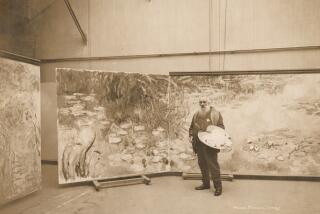Carrying on in Corot’s name
- Share via
French artist Jean-Baptiste-Camille Corot -- who earned a hallowed place in art history by infusing 19th century landscape painting with a fresh breath of realism -- credited his teacher, Achille Etna Michallon, with advising him “to reproduce as scrupulously as possible what I saw in front of me.”
Unfortunately for Corot purists, lesser artists reproduced the master’s style as scrupulously as possible in paintings of their own and passed them on as his work.
Art historians say Corot did authorize some of his imitators to put his signature on their paintings so they could charge higher prices. But his popularity and generosity have given him the dubious distinction of being the world’s most faked artist.
That’s the conclusion of a survey conducted by ARTnews and published in the June issue of the New York-based magazine. Rubens and Rembrandt, whose authorship is often questioned, are not on the list of “The 10 Most Faked Artists.” But Corot has lots of company: Giorgio de Chirico, Salvador Dali, Honore Daumier, Vincent van Gogh, Kazimir Malevich, Amedeo Modigliani, Frederic Remington, Auguste Rodin and Maurice Utrillo.
Not all works now deemed to be forgeries were executed with fraudulent intent. Works made entirely or in part by artists’ assistants, copies by talented students, signatures added long after the paint was dry and mistaken attributions all contribute to the confusion.
What’s to be done? The magazine ends its report with a quote from the late Theodore Rousseau, vice director and curator in chief of the Metropolitan Museum of Art in New York: “We should all realize that we can only talk about the bad forgeries, the ones that have been detected; the good ones are still hanging on the walls.”
*
-- Suzanne Muchnic
More to Read
The biggest entertainment stories
Get our big stories about Hollywood, film, television, music, arts, culture and more right in your inbox as soon as they publish.
You may occasionally receive promotional content from the Los Angeles Times.








